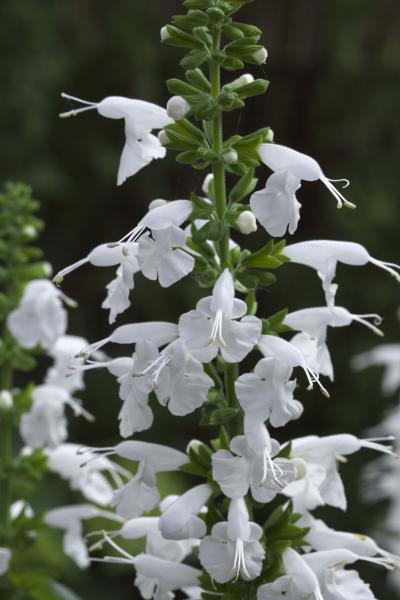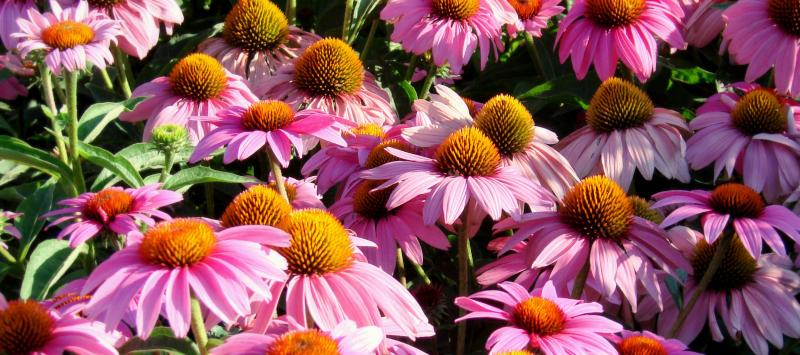Winners Circle
Gardens in 2015 are seeing bold colors and drought-resistant, easy-to-care-for plants that are suitable for containers, borders and landscapes. Each year, GPN compiles a list of award-winning varieties for the year to share with readers. Judges have looked for unique appearances, weather tolerances, growth habits and other factors. Using these elements and more, the following plants were awarded with this year's top honors.
All-American Selections
Dianthus, Interspecific 'Jolt Pink' (PanAmerican Seed). This variety has brightly colored and large, showy flower heads on strong stems that perform well all summer.Jolt is bred for extreme heat tolerance with bright pink fringed flowers. It is shorter on the bench, which makes it better for shipping, and the uniform blooms last up to four weeks longer than the comparison varieties, making it an attractive option for landscapers.

Impatiens 'Bounce Pink Flame' (Selecta). Bounce looks like an Impatiens walleriana in habit, flower form and count. It is downy mildew resistant so impatiens last from spring through fall in the shade or sun. 'Bounce Pink Flame' contains bright pink, bicolor blooms.

Impatiens 'SunPatiens Spreading Shell Pink' (Sakata Ornamentals). These impatiens deliver season-long, soft pink flowers with strong roots that quickly take hold after transplanting. They thrive under high heat, rain and humidity and keep their shape all summer long, doing well in full sun and shade. The low-maintenance plants are resistant to downy mildew.

Petunia 'Tidal Wave Red Velour' (Pan American Seed). Any time-crunched gardener looking for petunias that are carefree should choose Tidal Wave. Its deep red, velvety blooms will not fade in the heat of summer, and as the tallest of the Wave family, they will re-bloom all season long and recover quickly, even after hard rains.
The vigorously spreading plants rarely need deadheading as new blooms continuously pop up and cover old blooms. Tidal Wave covers a large area quickly, making it a first-rate landscape performer.

Petunia 'Trilogy Red' (Takii & Co. Ltd.). The Trilogy petunia series welcomes this new color. Trilogy petunias, known for their compact dome-shaped habit sporting large non-fading blooms throughout the season, cover and recover themselves in upright blooms and provide a constant mass of color in flower beds, baskets and containers.
Trilogy performs in high heat areas and bounces back after rain. For this series, there was less need for PGRs and on the bench, the controlled growth habit means tidier plants that are easier to separate and ship.

Salvia 'Summer Jewel White' (Takii & Co. Ltd.). This dwarf-sized compact plant has an abundant bloom count throughout the summer, with blooms appearing almost two weeks earlier than other white salvias.
Bees, butterflies and hummingbirds love the large flowers, making it a perfect pollinator garden. 'Summer Jewel White' is perfect for large landscape areas, containers and small beds because of its compactness and number of flowers.
American Garden Award Winner

Digiplexis 'Illumination Flame' (Cultivaris). A cross between digitalis and the Mediterranean shrub isoplexis, the hybrid resulted in a well basal branched, vigorous, colored and long blooming foxglove.
The variety flowers for several months, beginning in mid-spring and continues through the summer until the first hard frost. The 2-inch tubular, hooded flowers have fuchsia-pink tones on the outside with blooms that transition from fuchsia pink to golden apricot throats streaked with lavender spots on the inside.

Petunia 'Sanguna Radiant Blue' (Syngenta Flowers). With a bicolor flower pattern, this hybrid petunia works well on porches, decks and in garden beds. The petunia has early and continuous flowering, prefers full sun and blooms mid season.
Celosia 'Arrabona Red' (PanAmerican Seed). With masses of red-orange plumes that will last all summer, 'Arrabona Red' is easy to care for, drought tolerant and performs well in the heat making it perfect for tropical, subtropical and continental climates. It is exceptionally long-flowering when used in borders or containers.
Fleuroselect

Calamintha nepeta 'Marvelette Blue' (Van Hemert & Co.). This first-year flowering perennial flowers within 12 weeks from spring sowing. The mint smell of the mid-green foliage attracts butterflies and bees. It makes a great filler in sunny borders and can also be used as an edging for walks or as a potted plant.

Cosmos bipinnatus 'Xanthos' (Van Hemert & Co.). The dwarf, early flowering (from June to September) yellow 'Xanthos' is fitting for the patio or terrace. Because of its compactness, 'Xanthos' is ideal for transport, with a short production time that makes it an early-season attraction. The yellow is new to the compact cosmos range.

Echinacea purpurea 'Feeling Pink' (HM. Clause). Blooming from May-June until September-October, the rose-colored flowers attract bees and other insects; it is also suitable for cutting. Performs well in tough conditions such as wind, heat and dry soil, and due to a shorter cycle, 'Feeling Pink' is easy to produce and allows for a higher rotation in growing schemes. The variety is also compact and displays a good basal branching habit.

Helenium autumnale 'Western Mixture' (HM. Clause). The highly floriferous perennial is dwarf, compact, early flowering and will embrace any border from summer until the end of autumn. 'Western Mixture' offers masses of yellow, red and bicolor red/yellow flowers. Its better branching allows for growth in a wider range of pots and its compactness enables efficient transport.

Ocimum basilicum 'Purple Ball' (NARIC Fruitculture). This aromatic annual has original, small purple leaves and small, tubular purple flowers. It thrives in sunny, warm weather and is drought resistant. Purple Ball can work in a pot, as a filler in balcony boxes and in flower beds.

Petunia 'Tidal Wave Red Velour' (PanAmerican Seed). Due to its spreading habit, this petunia (also an AAS Flower Award Winner) is a fast grower and can wind around a fence to create a hedge; make ground cover in a bed; or fill a large container as a patio showpiece. It has a long-flowering season and excellent rain resistance.
Association of Specialty Cut Flower Growers

Celosia 'Sunday Orange' (PanAmerican Seed). Short, programmable production time and high stem yield makes Sunday ideal for high-density cut flower programs. Sunday has full plumes; long, strong stems; and has excellent shipability and vase life.

Caryopteris 'Longwood Blue' (Longwood Gardens). This variety was named after its breeder and violet-blue flowers. The foliage is silvery-gray, lance shaped and aromatic. This is a favorite woody plant for flower growers because of its sturdy stems, stunning color and long vase life. It blooms mid-late summer into fall.

Ranunculus La Belle Series (Comptoir-Paulinois). This series is fully double flowering; has high production (nine to 15 stems per tuber); 21 homogenous colors; early uniform flowering and large flowers on tall, sturdy stems.
Ranunculus may be grown in the same greenhouse as other plants, but its best growth will come from night temperatures of 45-48 ¡F, and day temperatures of 58-65 ¡F. Corms planted in early October should start producing flowers in January and continue through April.
American Hosta Growers Association

Hosta 'Victory' (Zilis/Solberg 2003). Maturing on average to 38 inches in height with an 88-inch spread, 'Victory' rivals in the giant, upright, variegated category. Individual leaves measure 17 inches long and 13 inches across. The hosta has a shiny, dark green center and a yellow to creamy-white margin. Near white flowers are born on 6-foot-tall scapes in midsummer.
Perennial Plant Association

Geranium x cantabrigiense 'Biokovo'. The 2015 Perennial Plant of the Year performs best in sun to partial shade and prefers average, well-drained soil. Its delicate pinkish-white flowers in spring give way to reddish orange leaves in the fall.
It blooms in late spring with masses of five-petaled white flowers about _ inches in diameter. The perennial reaches 6-10 inches tall, tends to be deer and rabbit resistant, is hardy in Zones 4 to 8 and only requires deadheading .


 Video Library
Video Library 



















